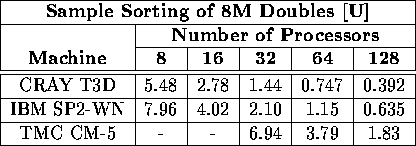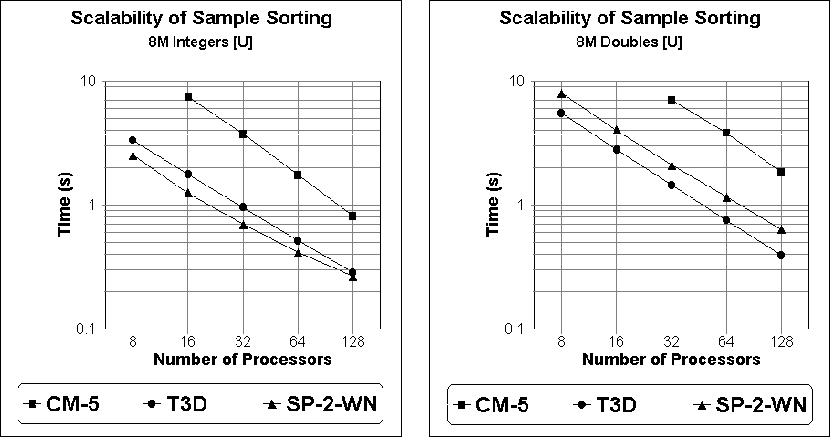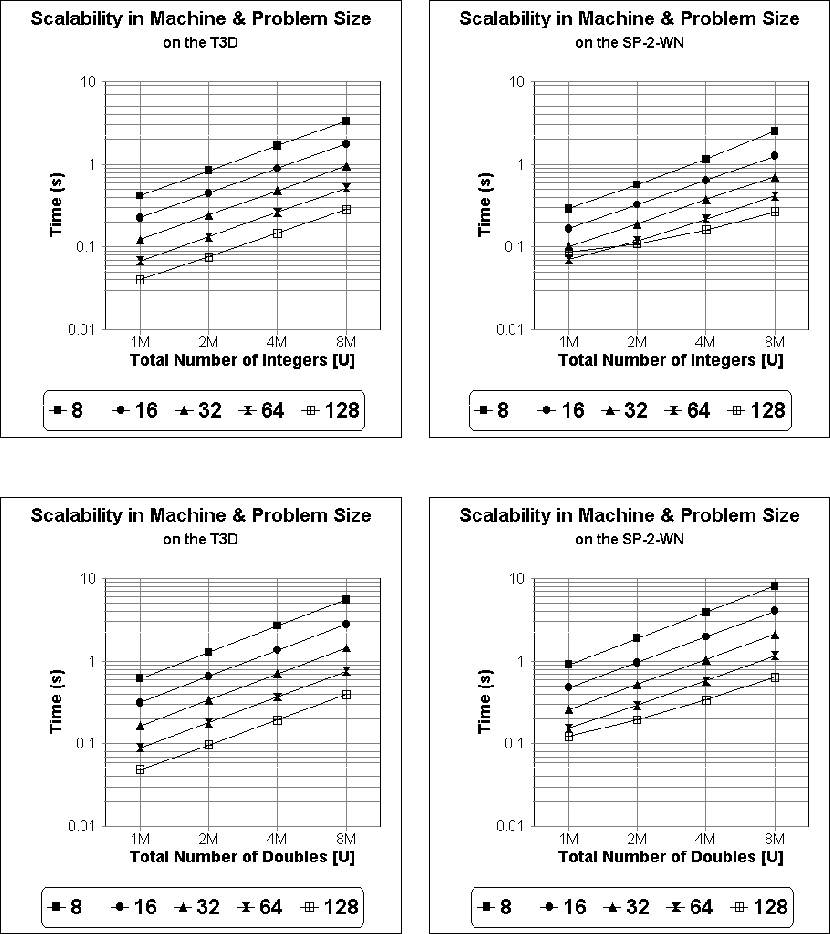For each experiment, the input is evenly distributed amongst the
processors. The output consists of the elements in non-descending order
arranged amongst the processors so that the elements at each processor
are in sorted order and no element at processor ![]() is
greater than any element at processor
is
greater than any element at processor ![]() , for all i < j.
, for all i < j.
Two variations were allowed in our experiments. First, radix sort was used to sequentially sort integers, whereas merge sort was used to sort double precision floating point numbers (doubles). Second, different implementations of the communication primitives were allowed for each machine. Wherever possible, we tried to use the vendor supplied implementations. In fact, IBM does provide all of our communication primitives as part of its machine specific Collective Communication Library (CCL) [8] and MPI. As one might expect, they were faster than the high level SPLIT-C implementation.

Table i: Total execution time (in seconds) required to sort a variety of
integer benchmarks on a 64-node Cray T3D.

Table ii: Total execution time (in seconds) required to sort a variety of
integer benchmarks on a 64-node IBM SP-2-WN.

Table iii: Total execution time (in seconds) required to sort a variety
of double benchmarks on a 64-node Cray T3D.

Table iv: Total execution time (in seconds) for required to sort a variety
of double benchmarks on a 64-node IBM SP-2-WN.
Tables i, ii, iii, and iv display the performance of our sample sort as a function of input distribution for a variety of input sizes. In each case, the performance is essentially independent of the input distribution. These tables present results obtained on a 64 node Cray T3D and a 64 node IBM SP-2; results obtained from the TMC CM-5 validate this claim as well. Because of this independence, the remainder of this section will only discuss the performance of our sample sort on the single benchmark [U].

Table v: Total execution time (in seconds) required to sort 8M integers
on a variety of machines and processors using the [U] benchmark.
A hyphen indicates that particular platform was unavailable to us.

Table vi: Total execution time (in seconds) required to sort 8M doubles
on a variety of machines and processors using the [U] benchmark.
A hyphen indicates that particular platform was unavailable to us.

Figure 1: Scalability of sorting integers and doubles with respect
to machine size.
The results in Tables v and vi together with
their graphs in Figure 1 examine the scalability of our sample
sort as a function of machine size. Results are shown for the T3D, the
SP-2-WN, and the CM-5. Bearing in mind that these graphs
are log-log plots, they show that for a fixed input size n the
execution time scales almost inversely with the number of processors
p. While this is certainly the expectation of our analytical model
for doubles, it might at first appear to exceed our prediction of an
![]() computational complexity for integers.
However, the appearance of an inverse relationship is still quite
reasonable when we note that, for values of p between 8 and 128,
computational complexity for integers.
However, the appearance of an inverse relationship is still quite
reasonable when we note that, for values of p between 8 and 128,
![]() varies by only a factor of
varies by only a factor of ![]() .
Moreover, this
.
Moreover, this ![]() complexity
is entirely due to the merging in Step (8), and in practice,
Step (8) never accounts for more than
complexity
is entirely due to the merging in Step (8), and in practice,
Step (8) never accounts for more than
![]() of the observed execution time. Note that the complexity
of Step 8 could be reduced to
of the observed execution time. Note that the complexity
of Step 8 could be reduced to ![]() for integers
using radix sort, but the resulting execution time would, in most cases,
be slower.
for integers
using radix sort, but the resulting execution time would, in most cases,
be slower.
The graphs in Figure 2 examine the scalability of our sample
sort
as a function of problem size, for differing numbers of processors.
They show that for a fixed number of processors there
is an almost
linear dependence between the execution time and the total number of
elements n. While this is certainly the expectation of our analytic
model for integers, it might at first appear to exceed our
prediction of a ![]() computational complexity for
floating point values. However, this appearance of a linear
relationship is still quite reasonable when we consider that for the
range of values shown
computational complexity for
floating point values. However, this appearance of a linear
relationship is still quite reasonable when we consider that for the
range of values shown ![]() differs by only a factor of 1.2.
differs by only a factor of 1.2.

Figure 2: Scalability of sorting integers and doubles with respect to the
problem size, for differing numbers of processors.
Next, the graphs in Figure 3 examine the
relative costs of the eight steps in our sample sort.
Results are shown for both a 64 node T3D and a 64 node SP-2-WN,
using both the integer and the double versions of the [U] benchmark.
Notice that for n = 64M integers, the sequential sorting and merging
performed in Steps (3) and (8) consume approximately ![]() of the execution time on the T3D and approximately
of the execution time on the T3D and approximately ![]() of the execution
time on the SP-2. By contrast, the two transpose operations in
Steps (2) and (7) together consume only about
of the execution
time on the SP-2. By contrast, the two transpose operations in
Steps (2) and (7) together consume only about ![]() of the
execution time on the T3D and about
of the
execution time on the T3D and about ![]() of the execution time on the
SP-2. The difference in the distribution between these two platforms is
likely due in part to the fact that an integer is 64 bits on the T3D
while only
32 bits on the SP-2. By contrast, doubles are 64 bits on both platforms.
For n = 64M doubles, the sequential sorting and merging
performed in Steps (3) and (8) consume approximately
of the execution time on the
SP-2. The difference in the distribution between these two platforms is
likely due in part to the fact that an integer is 64 bits on the T3D
while only
32 bits on the SP-2. By contrast, doubles are 64 bits on both platforms.
For n = 64M doubles, the sequential sorting and merging
performed in Steps (3) and (8) consume approximately ![]() of the execution time on both platforms, whereas the two transpose
operations in Steps (2) and (7) together consume only about
of the execution time on both platforms, whereas the two transpose
operations in Steps (2) and (7) together consume only about
![]() of the execution time. Together, these results show that our
algorithm is extremely efficient in its communication performance.
of the execution time. Together, these results show that our
algorithm is extremely efficient in its communication performance.

Figure 3: Distribution of execution time amongst the eight steps of
sample sort. Times are obtained for both a 64 node T3D and
a 64 node SP-2-WN using both the integer and the double versions
of the [U] benchmark.
Finally, Tables vii and viii show the
experimentally derived expected value (E) and sample standard
deviation (STD) of the coefficients ![]() ,
, ![]() ,
, ![]() ,
and
,
and ![]() used to describe the complexity of our algorithm
in Section 3. The values in Table vii were obtained
by analyzing data collected while sorting each of the duplicate benchmarks
[DD] and [RD] 50 times on a 64-node Cray T3D. For each trial,
the values recorded were the largest occurrence of each coefficient at any
of the 64 processors. By contrast, the values in
Table viii were obtained by analyzing data collected while
sorting each of the unique benchmarks [G], [B],
[2-G], [4-G], and [S] 20 times. In every trial, a
different seed was used for the random number generator, both to generate
the benchmark where appropriate and to distribute the keys into bins
as part of Step (1). The experimentally derived expected values in
Table vii for
used to describe the complexity of our algorithm
in Section 3. The values in Table vii were obtained
by analyzing data collected while sorting each of the duplicate benchmarks
[DD] and [RD] 50 times on a 64-node Cray T3D. For each trial,
the values recorded were the largest occurrence of each coefficient at any
of the 64 processors. By contrast, the values in
Table viii were obtained by analyzing data collected while
sorting each of the unique benchmarks [G], [B],
[2-G], [4-G], and [S] 20 times. In every trial, a
different seed was used for the random number generator, both to generate
the benchmark where appropriate and to distribute the keys into bins
as part of Step (1). The experimentally derived expected values in
Table vii for ![]() ,
, ![]() ,
,
![]() , and
, and ![]() agree strongly with the theoretically derived
bounds for duplicate keys of
agree strongly with the theoretically derived
bounds for duplicate keys of ![]() ,
, ![]() ,
,
![]() , and
, and ![]() for
for ![]() .
Similarly, the experimentally derived expected values in
Table viii for
.
Similarly, the experimentally derived expected values in
Table viii for ![]() ,
, ![]() ,
,
![]() , and
, and ![]() agree strongly with the theoretically derived
bounds for unique keys of
agree strongly with the theoretically derived
bounds for unique keys of ![]() ,
, ![]() ,
,
![]() , and
, and ![]() for
for ![]() .
Note that expected values for
.
Note that expected values for ![]() and
and ![]() are actually less for
duplicate values than for unique values, which is the opposite
of what we might expect from the computed bounds. This might simply
reflect our limited choice of benchmarks, or it may suggest that the
bounds computed for duplicate are looser than those computed
for unique values.
are actually less for
duplicate values than for unique values, which is the opposite
of what we might expect from the computed bounds. This might simply
reflect our limited choice of benchmarks, or it may suggest that the
bounds computed for duplicate are looser than those computed
for unique values.

Table vii: Statistical evaluation of the experimentally observed values of
the algorithm coefficients on a 64 node T3D using the duplicate benchmarks.

Table viii: Statistical evaluation of the experimentally observed values of
the algorithm coefficients on a 64 node T3D using the unique benchmarks.